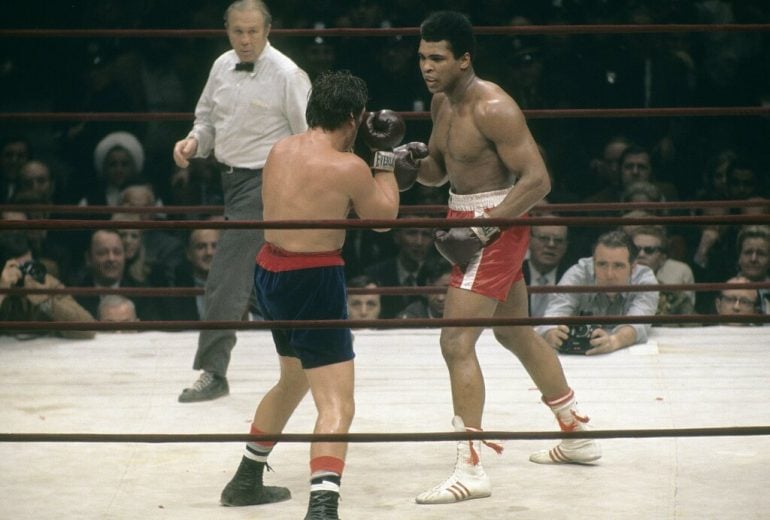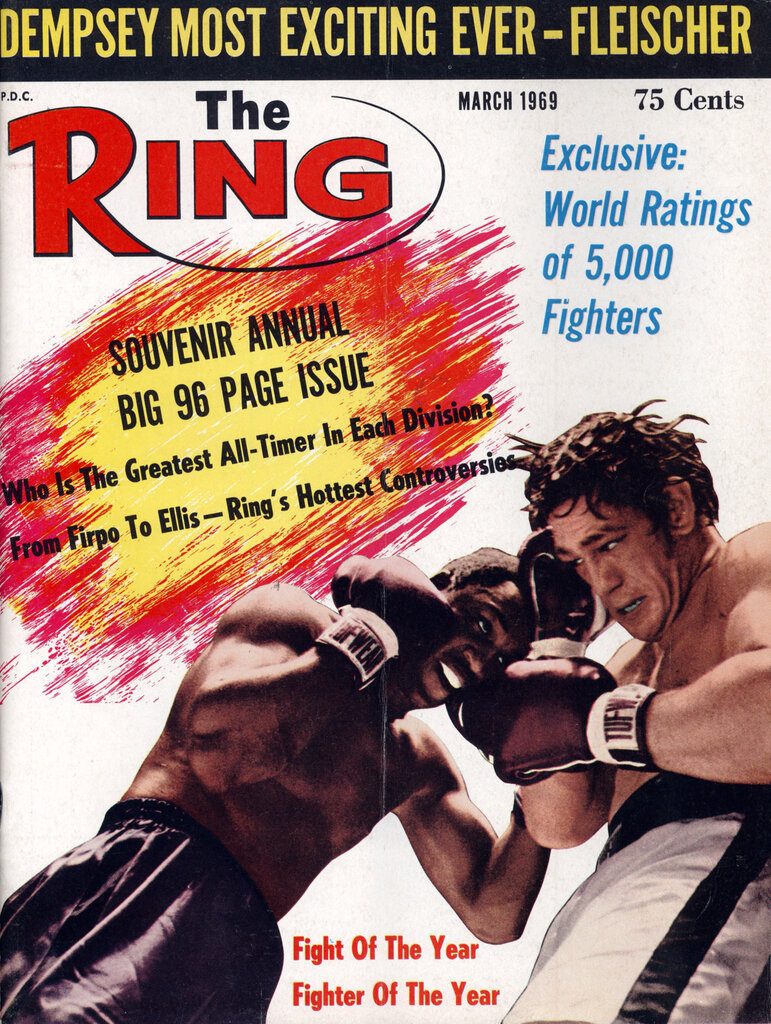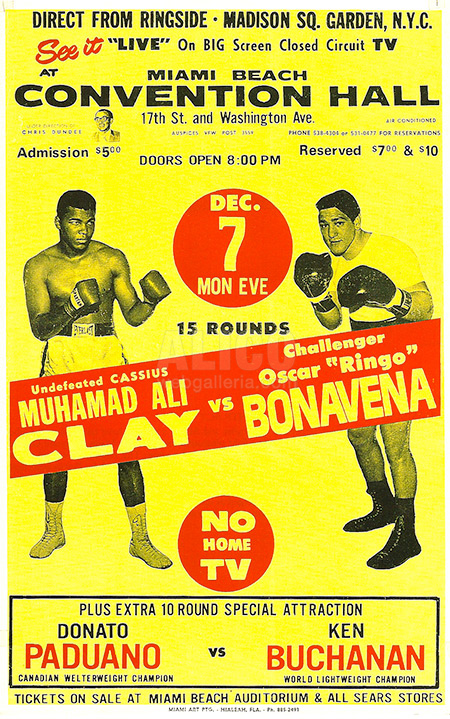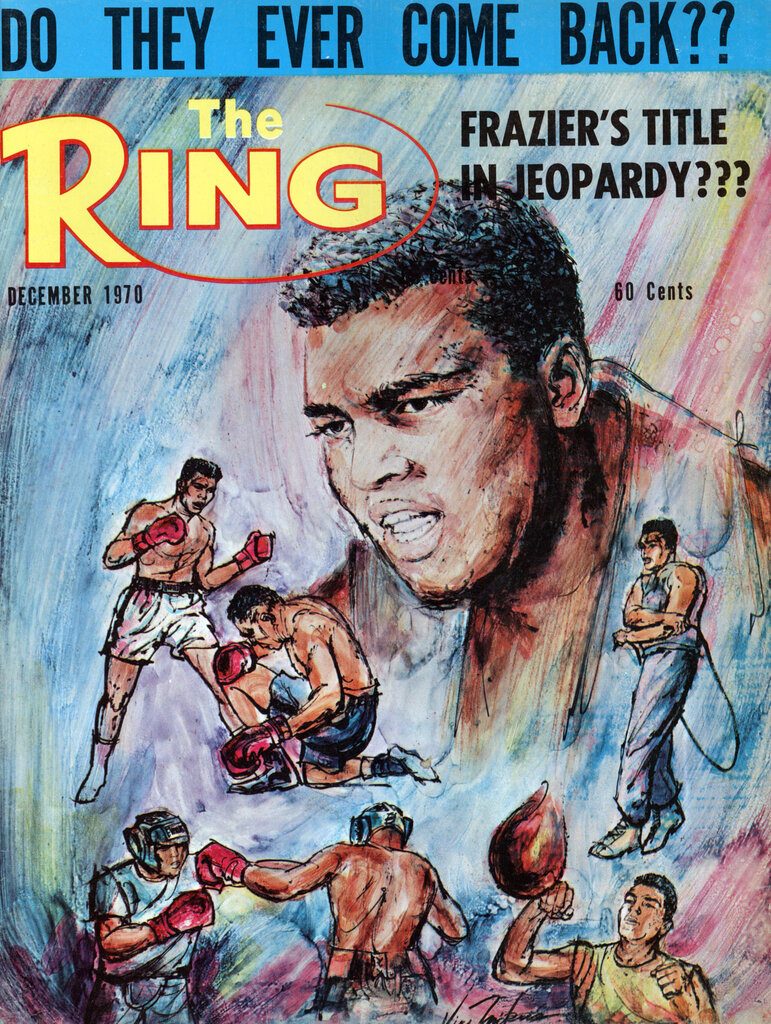Muhammad Ali-Oscar Bonavena: The Greatest versus Ringo 50 years later

Fifty years ago today, Muhammad Ali continued his march toward regaining the championship that was stripped from him due to his refusal to serve in the U.S. military during the Vietnam War. His first fight following his three-and-a-half-year exile — a three-round cut-induced corner-retirement TKO victory versus Jerry Quarry in October 1970 — was cosmetically pleasing but answered few questions regarding how he would fare against Joe Frazier, the man who succeeded Ali as champion. Ali’s next opponent, Argentine strongman Oscar Bonavena, promised to offer a much better measuring stick because of how he performed against “Smokin’ Joe” in their two fights.
The following is an excerpt from “Muhammad Ali: By the Numbers” by CompuBox president and co-founder Bob Canobbio and writer/historian/researcher/punch-counter Lee Groves, a book that was released in 2018 and is available for purchase on Amazon.com and other web sites where books are sold. With the holidays fast approaching, “Muhammad Ali: By the Numbers” would make an excellent gift for anyone who loves boxing, sports, history and intrigue.
And now, without further delay, let’s travel back a half-century and relive one of the most grueling fights in Muhammad Ali’s boxing life.
*
The week after a federal judge permitted New York state to issue Ali a boxing license in September 1970, it was announced that Ali would fight Oscar Bonavena at Madison Square Garden on December 7. Since Ali was originally set to face Bonavena in Tokyo two months after he stopped Folley, this fight would close a circle of sorts. But it also was designed to give Ali a chance to gauge himself against Frazier because the Argentine gave “Smokin’ Joe” two of his toughest fights.
In the second round of their first encounter in September 1966, the then-South American champion twice drove Frazier to the floor and nearly had him out. But Frazier showed his mettle by sweeping the next four rounds on his way to capturing a demanding 10 round split decision, the first distance fight of the American prospect’s 11-fight pro career. They met again in December 1968 and this time, Frazier, who was making the second defense of his New York State Athletic Commission title, was taken the 15-round distance for the first time. While Bonavena came out on the short end again, his physicality thoroughly tested Frazier’s stamina.
Nicknamed “Ringo” for his floppy Beatles-like haircut, Bonavena loved to pound both hands against his opponents’ ribs as much as Ringo Starr hammered his drum skins. His persistent aggression and unpredictable punching patterns often wrecked the timing of more skillful foes and helped him to match (and even exceed) the production of those who fought in similar fashion. His best wins came against George Chuvalo (a majority W 10), back-to-back victories against Tom McNeeley (KO 5) and Dick Wipperman (W 10) in his sixth and seventh pro bouts, Gregorio Peralta (W 12) for the South American title in their first of two fights, Karl Mildenberger (W 12) in Frankfurt as part of the WBA’s heavyweight title tournament, Leotis Martin (W 10) and onetime title challenger Manuel Ramos (KO 1). The Ramos win was one of five straight KO wins Ringo rung up before meeting Ali, vaulting his record to 46-6-1 with 37 knockouts.

Bonavena and Frazier. March 1969 issue
When Bonavena lost, it usually was to proven opponents, as four of his six defeats came against Jimmy Ellis (L 12) in the WBA heavyweight title elimination tournament, Frazier (L 10, L 15) and Zora Folley (L 10). It was telling that Bonavena’s pro debut, a first-round knockout against Lou Hicks in January 1964, took place at Madison Square Garden, and entering the Ali fight his record there was 6-2 with four knockouts. As for Ali, his MSG mark was 3-0 with two knockouts.
Bonavena’s wildness in the ring occasionally strayed beyond the Marquess of Queensberry rules. On one occasion, however, he ventured far beyond them. Like the time he bit an opponent during the finals of the 1963 Pan-American Games in Sao Paulo, Brazil.
“Sometimes, when athletes couldn’t win, they bit back,” Los Angeles Times writer Earl Gustkey opined in an August 1987 column. “A then little-known Argentine heavyweight boxer, Oscar Bonavena, was knocked down in the first round by American Lee Carr. Rising to his feet and spitting out his mouthpiece, the frustrated Bonavena promptly sank his teeth into Carr’s forearm, and was disqualified.” (1)
“Everybody asks about that,” Bonavena told THE RING’s Dan Daniel in February 1965. “I don’t mind telling.
“Well, the American was tough,” he began. “I hit him on the chin. As he fell he grabbed me. I tried to get free. He held on tighter, I was getting angrier by the second. Then I threw one and missed. I slipped. The referee ruled it a knockdown and started to count. I still could not get myself loose from Carr and then I did it. I bit him. Well, I bit myself out of the Pan-American championship. I since have been told by (trainer) Charley Goldman that in the professional ring a well-placed, hard bite doesn’t count for a point. It was silly, and that’s that.” (2)
No matter how this “bite fight” unfolded, the Carr bout was one of only two losses in Bonavena’s 48-fight amateur career, which included 36 knockout wins. (3) His wayward methods continued into his professional career, for two of his six defeats coming into the Ali fight were by disqualification (DQ 8 in his first fight against Jose Giorgetti, who Bonavena defeated by 10-round decision just 35 days later, and a seventh-round disqualification against Miguel Angel Paez for excessive low blows in January 1970, just six fights before meeting Ali).
Still, Bonavena entered the fight as the WBA’s number-one contender, so, for Ali, the 6-to-1 favorite, (4) a victory not only would catapult him into the dream match with Frazier, it also would justify it.
The rugged Bonavena was expected to test Ali’s conditioning, punching power and tolerance for rough fighting. Also, unlike Quarry, Bonavena was not a chronic cutter, so, if history held, Ali would not be given that potential shortcut ending.
As usual, Ali utilized his pre-fight shtick to generate interest and rattle his opponent, but Bonavena took everything in stride and eagerly returned the favor. His high-pitched voice, broken English and abundant charisma charmed both the press and Ali himself.
When the pair underwent their medical exam, Bonavena was comfortable, amiable and willing to go toe-to-toe with Ali rhetorically despite the language barrier. He pointed at his bulging bicep, saying, “Argentina is strong,” and playfully stuck out his chin when Ali said Bonavena wouldn’t hit him like he had Frazier. When Ali asked a Spanish interpreter to ask Bonavena which round he would score the knockout, Bonavena pointed to his head to indicate he had seen through Ali’s ploy, smiled broadly and said, “no! Surprise!”, a response that generated gales of laughter from the audience and earned a big grin from Ali. The final jousting saw Ali throw a series of jabs that fell inches short of Bonavena’s face. When Ali slapped down Bonavena’s left hand, the bemused Argentine’s face darkened slightly. He then gave Ali a quick head-and-shoulder feint that made the ex-champ flinch, triggering another round of laughter and another smile from Ali. As Ali turned away he knew the South American had scored a rare win in the battle of wits. (5)
Ali’s arrival was greeted with far more cheers than boos, a further indication of the shifting perceptual and cultural attitude toward the former champion, who, for the first time, sported red tassels on his shoes. Another indicator of his popularity was that an enormous crowd of 19,417 flowed into the Garden to see what would unfold. (6)
The profound contrast in style and ring temperament was made obvious within seconds as the athletically fluid Ali cut clockwise circles and the stiffly coiled Bonavena fired wild hooks with abandon. His crude but effective upper body movement allowed him to slip nearly as many blows as Ali as well as avert the former champion’s vaunted jab throughout round one, a round that saw Ali go 11 of 38 to Bonavena’s 10 of 37 as well as 5 of 18 in jabs to the South American’s 3 of 16. A potential trouble spot for Bonavena: Low blows. One that connected in the first minute drew a caution from referee Mark Conn while another at the end of the round prompted a stronger warning.
Yank Durham, the manager of heavyweight champion Joe Frazier, was doing color commentary with ABC’s Howard Cosell, and though he had an inherent bias his wizened eyes correctly foresaw that Ali was in for a rough evening.
One concession to Bonavena’s physicality occurred early in round two when Ali opted to fight more flat-footedly instead of engaging in his trademark leftward circle, for even then he must have suspected that he would need to marshal his resources if he was forced to go longer than his predicted nine rounds. Even so, Ali’s jab began to land more frequently (11 of 27) and accurately (41%) while Bonavena’s performance level dropped slightly (7 of 37 overall, 19%, 6 of 18 power, 33%). At the bell, Bonavena dropped his arms and glared at Ali, who got a rise from the crowd when he responded with a dismissive wave of the glove.
 The war of styles continued in the third, and while Ali got in a pair sharp one-twos and managed to keep the fight at long range and at ring center, Bonavena’s quirky timing and roundhouse blows occasionally disrupted Ali’s rhythm as well as the flow of the contest. Following the third round bell, moments after Bonavena whiffed on an awkwardly delivered hook, Ali pointed to the ground and yelled at Bonavena as if to say, “you’re going down!”
The war of styles continued in the third, and while Ali got in a pair sharp one-twos and managed to keep the fight at long range and at ring center, Bonavena’s quirky timing and roundhouse blows occasionally disrupted Ali’s rhythm as well as the flow of the contest. Following the third round bell, moments after Bonavena whiffed on an awkwardly delivered hook, Ali pointed to the ground and yelled at Bonavena as if to say, “you’re going down!”
But Bonavena didn’t go down. In fact, he grew stronger.
The fourth was Bonavena’s best to date as he charged Ali behind his whirlybird blows and forced him toward the ropes much more consistently. A growingly concerned Cosell perfectly summarized Bonavena when he called him “powerful, awkward, cumbersome, ponderous, but the aggressor.” Ali initiated more of the clinches, prompting some to wonder whether Ali truly had enough gas in the tank to successfully navigate the 15-round distance. Cosell remarked that Ali had not looked this bad since the Karl Mildenberger fight in 1966, where the German’s southpaw style had troubled Ali as few had before or since. In the fourth, Bonavena threw 56 punches and landed 17, both fight highs thus far, while Ali’s output slipped to 26, landing 10.
The audience that had cheered Ali upon his arrival now buzzed with concern. They knew this wasn’t the Ali that was universally acknowledged as the fastest heavyweight to ever live. Instead, this was a fighter that had to access other resources to get by. Had they met in 1967 as planned, that version of Ali probably would have easily out-speeded the South American en route to a wide points victory but here, more than three years later, the toll of Ali’s forced inactivity and the erosion of his otherworldly skills were being laid bare. The harsh reality was that Ali no longer had all the poetry and the ballet at his disposal. If he was to win — and the concept behind the word “if” was becoming more believable — he would have to stand and fight.
Ali started round five with flashes of the float and sting but Bonavena was unmoved and unimpressed. He shrugged off Ali’s arrows and continued to burrow inside with his cannonballs, one of which strayed below the belt and induced another warning from Conn. As the round closed, Ali resorted to a tactic he rarely employed: Jabbing to the body. Five landed in the final 30 seconds, which accounted for half of the jabs he landed in the round. Those 10 jab connects helped him forge a narrow 13-10 lead overall, but Bonavena’s 8-3 bulge in landed power shots certified his effectiveness.
Durham was genuinely concerned that Frazier’s showdown with Ali was in danger, saying “I’m a little afraid for Clay because Bonavena is going to get stronger. I see he’s breathing hard over there. I don’t think Clay could stand this pace.”
Durham was right to be worried, and the disturbing pattern from his standpoint continued throughout the middle rounds as Bonavena gave as good as he got, and sometimes a bit better. A heavy hook early in the sixth drove Ali backward, inspiring one section of the crowd to begin chanting “Ringo! Ringo!” and for the usually optimistic Dundee to signal his puzzlement to Cosell. Drew “Bundini” Brown’s cries of “the heavy bag” now had a pleading tone. A fight involving Ali was riveting in itself, but here two elements were introduced to the mix — drama and suspense.
With every passing round those elements became more relevant. In fact, Bonavena exceeded Ali’s total in overall connects in rounds eight through 13, a six-round stretch of success that once would have been unthinkable. That success also included the ninth, in which Ali had said Bonavena “would be mine.”
To pull this fight out of the fire, Ali would have to rally.
Fortunately for him, his team and the millions who dearly wanted the Frazier fight to be made, he did. And, in typical Ali fashion, he did so with magnetism and flair.
With Brown repeatedly telling Ali to “close the show” throughout round 15, Ali connected with a pair of heavy hooks that suddenly sent Bonavena toppling to the floor and landing heavily on his left side. The crowd that had been sullen sprang to life, with one ringsider leaping up and down in rapturous joy. As usual, Ali never retreated to a neutral corner as Conn tolled the count, which reached five when Bonavena regained his feet. Ali’s next punch, a right to the face, downed the dizzy Bonavena for the second time, prompting Ali to stand over his prey and raise his hands above his head. Conn tried to push Ali away but his efforts were futile. Ali was in full fighting fury and nothing, even the neutral corner rule that had been in effect since the 1920s, would deny him the finish he craved.
A big right hand to the face sent the near-helpless Bonavena to the canvas a third time, prompting Conn to wave off the fight, Ali to raise his arms in a victory pose and the Garden crowd to erupt in thunderous cheers. The concern that had enveloped them for so long was instantly replaced by a mixture of joy over the present and anticipation toward the future, a future that would now include Muhammad Ali versus Joe Frazier for the undisputed heavyweight championship.
Conn was the subject of post-fight criticism for the way he handled the 15th round knockdowns.
“In the 15th round, Conn failed to call the mandatory eight after Ringo had hit the deck for the first time, and also failed to order Clay to a neutral corner,” wrote RING founder Nat Fleischer. “Came a second knockdown and the referee again forgot the mandatory eight and the order to go to a neutral corner. A third knockdown ended the fight under the rule which hangs up a KO against a fighter who has been decked twice in one round.
“When so prominent, able and reputable a referee as Conn becomes flustered in so important a fight, there is something radically wrong with the system. Especially as sloppy work is followed by no public reprimand from the chairman of the governing commission,” Fleischer concluded. (7)

December 1970 issue
The final numbers were perilously close as Ali led 191-186 in total connects thanks to his 94-34 gap in landed jabs. Bonavena, for his part, landed far more power shots (152-97) and landed his hardest blows with more precision (38%-34%). The stats reflected the judgment of the Associated Press correspondent who had Ali ahead 7-6-1. (8) The official scorecards, however, indicated that Ali was never in any danger of defeat. Referee Conn had Ali up 12-2 while judges Joe Eppy (10-3-1) and Jack Bloom (8-5-1) scored similarly.
“The layoff bothered me,” Ali told Cosell. “It showed up, I missed a lot of punches. But I’m glad it went 15, the word was I didn’t have no stamina and I think I showed more than he did. Joe Frazier couldn’t stop him. He was really out! Now we have a chance to see who the real champion of the world is.”
Ali received one vote from the man who knew best: Oscar Bonavena.
“I’m sorry that I (called) you chicken,” he said moments after Ali apologized to him about his own pre-fight rhetoric. “You (are) champion. You win with Frazier because you (are) better. You (are) boxing very well. You win with Frazier. Because you whipped me, you beat Frazier!” (9)
Frazier, of course, disagreed.
“Until the 15th I had given Oscar every round,” Frazier said from his training camp in Monticello, N.Y. “I thought Clay fought dirty, pushing Oscar around and everything like that. I’ll be ready for him.” (10)
And the world would be ready for Ali versus Frazier.
INSIDE THE NUMBERS: Ali scored three knockdowns with just eight landed power punches in round 15. Ali tired down the stretch, averaging just 26.7 punches thrown per round over the last three rounds, landing 11 per round.
NOTES:
(1) “Pan Am Games Legacy 1959: It’s Not Exactly Peace and Harmony,” by Earl Gustkey, Los Angeles Times, August 6, 1987
(2) “Bonavena Carries Power, Strength Through 7 Wins,” by Dan Daniel, THE RING, February 1965, p. 22
(3) Ibid, p. 22
(4) “Three Knockdowns Give Ali Win,” by The Associated Press, published in the Observer-Reporter (Washington, Pa.), December 8, 1970, p. B-8
(5) https://www.youtube.com/watch?v=WIV7jx_3S_0&spfreload=10
(6) “Clay Takes 15 Rounds,” by The Associated Press, published in the Florence Times-Tri Cities Daily, p. 9
(7) “Nat Fleischer Speaks Out,” by Nat Fleischer, THE RING, April 1971, p. 5
(8) “Clay Takes 15 Rounds,” by The Associated Press, published in the Florence Times-Tri Cities Daily, p. 10
(9) https://www.youtube.com/watch?v=WIV7jx_3S_0&spfreload=10
(10) “Clay Takes 15 Rounds,” by The Associated Press, published in the Florence Times-Tri Cities Daily, p. 10
YOU MAY HAVE MISSED
MUHAMMAD ALI-JERRY QUARRY: HALF A CENTURY ON FROM THE RETURN OF THE CHAMPION
SUBSCRIBE NOW (CLICK HERE - JUST $1.99 PER MONTH) TO READ THE LATEST ISSUE
















